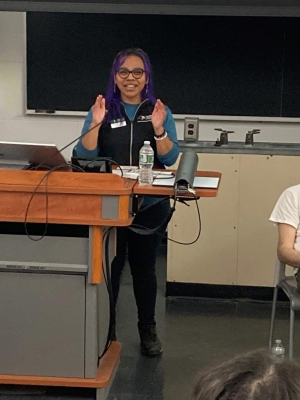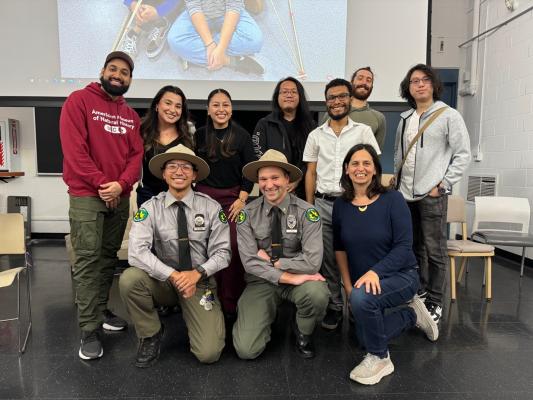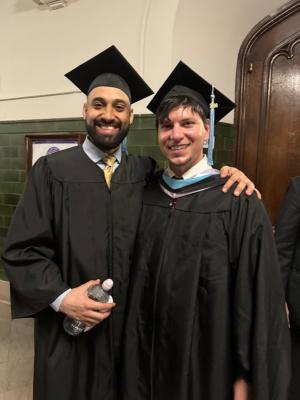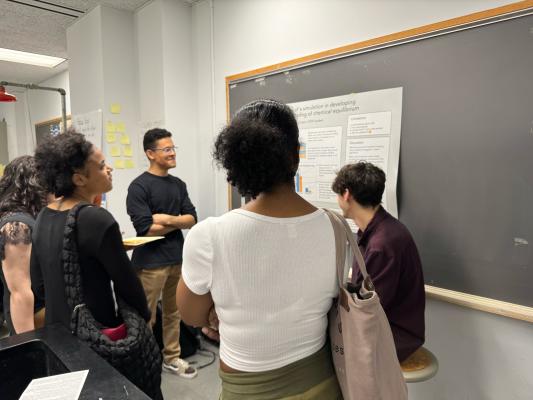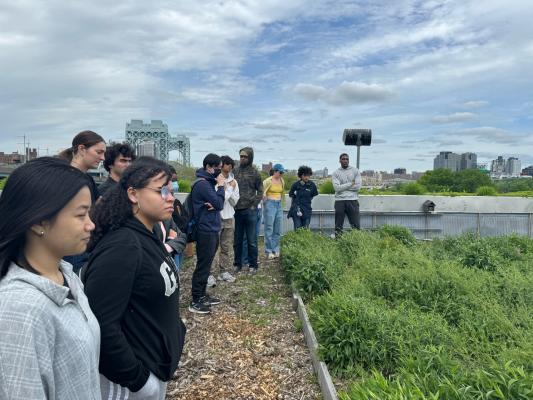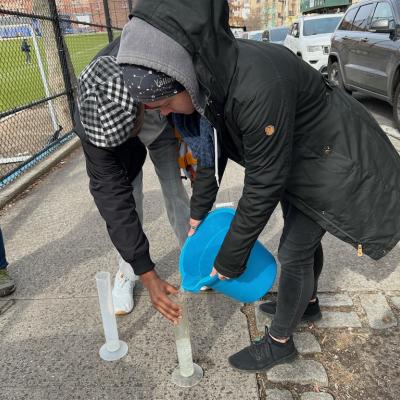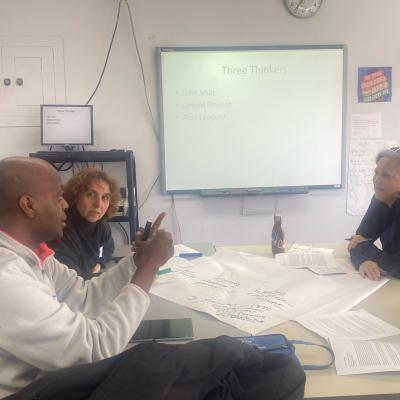The Science Learning & Public Engagement Career Paths Panel
The School of Education hosted our fourth career panel featuring educators from the New York Botanical Garden, New York State Department of Environmental Conservation, Battery Park City Authority, and the National Museum of Mathematics. Panelists spoke about their positions and shared about their non-formal science career journeys.
Photo: Mayra Sanchez shares about her work as an environmental educator at the New York State Department of Environmental Conservation.
Park ranger and CCNY science ed major Rafael Cruz prepares to educate the world
Before he became a New York City Park Ranger, Rafael Cruz knew that he wanted to be an environmental conservation educator, but was unsure how to channel that ambition when he first enrolled at The City College of New York as an undeclared major. Then, he had a chance encounter with Yael Wyner, an associate professor at the School of Education.
The director of SoE’s science education program, Wyner suggested to Cruz that he consider enrolling in the School’s Science Learning and Public Education major, which was established in 2021 to prepare students for a range of STEM education careers.
Science Education Alumni Panel
On November 11th, eight Science Education and Science Learning & Public Engagement alumni discussed their experience teaching in NYC public schools and working in full-time positions at the American Museum of Natural History, NYC Parks, City College, and Common Denominator.
For a spotlight on Rafael Cruz (front left) view this press release ...
CCNY School of Education Graduation
The Science Education congratulates two of our 2024 graduates!! We especially congratulate Akrm Ahmed (left) for being such an inspiring School of Education commencement speaker. Go Akrm!
Spring 2024 Science and Math Education Master’s Symposium
How Does Assessment Progress Tracking Impact Student Learning of Plate Tectonics?
Mike Loeb
My school emphasizes frequent student assessment and I wanted to learn whether increased student awareness of their academic performance would help improve performance on plate tectonic assessments. I randomly assigned half of my students to an experimental group (n = 59), which reviewed and visualized through graphs their assessment scores. The other student group acted as a control (n = 57) with no requirement to review their learning data. Results were mixed in terms of the impact of assessment monitoring on performance. Uncovered misconceptions include the idea that earthquakes can cause plates to travel large distances, that plates can float across the ocean, and that plates can move up from the mantle above existing plates.
How Do Hands-On Activities and Online Modules Compare in Impact on Student Engagement and Learning of Newton’s Laws of Motion?
Fabrizio Milito
Increased emphasis on online learning led me to wonder about its effectiveness as a learning tool. For this study, two different classes were assessed before and after a unit on Newtonian forces and motion. One class (n=19) learned with online modules using a software system with which they are familiar, and the other class (n=17) participated in in-person physical demonstrations and hands-on labs. Results indicate that while both classes showed learning growth, students that participated in physical activities tended to perform better on the post-assessments and to be more engaged. Findings show that although online modules can be effective, traditional physical activities and labs have a greater positive impact on student learning and engagement.
Math-Forward Science: Utilizing Student Knowledge about Proportions to Enhance Understanding of Gas Laws
George Schlinck
The Ideal Gas Law and other gas laws like it are some of the most vexing topics for high school chemistry students. Using a pre/post-test design in a study of 10th and 11th grade chemistry students (n=86), this study examined an approach of using outside student knowledge about proportional relationships to help learning of the behavior of gasses. This study showed that investigating the mathematics behind familiar direct and inverse proportions such as those between mass and density, or speed and time, helped students derive the Ideal Gas Law and others, and brought important misconceptions and thinking to the surface.
Identifying Students’ Misconceptions on Series and Parallel Circuits Mahindra Lall
Students struggle to disentangle the essential characteristics of current, voltage and resistance in electrical circuits. To better understand student misconceptions, Students (n=17) completed items from a validated assessment instrument (D.I.R.E.C.T.) before and after a unit on circuits, and interviews were conducted. Persistent misconceptions centered on how resistors impact current.
Assessing Student Understanding of the Structure and Function of Cellular Organelles: Does a Cell Organelle Puzzle Game Improve Student Ability to Draw Connections that Show the Relationships Between Organelles in a Cell?
Sherin Akther
Puzzles are a great strategy to help students grasp complex systems such as cells. Two 8th grade honors science classes, one acting as a control (n=16) and one as an experimental group (n=16), completed pre/post assessments, pre-surveys, and post interviews before and after a cell unit. Both groups received a traditional lesson on cells and organelles and completed a worksheet. The experimental group also completed a puzzle activity. Findings showed greater student improvement for the puzzle group in understanding cell organelle relationships. Results highlight the importance of incorporating engaging and interactive activities in developing students’ conceptual understanding.
How Does Technology Impact 9th Grade Student Learning of the Inverse of an Exponential Function?
Joan Martinez
This study used a pre/post control, treatment design to examine how technology impacts 9th grade student learning of logarithmic functions. The control group (n=29) learned without technology and the treatment group (n=28) learned with Desmos, an interactive visualization tool for learning abstract concepts. Findings show that treatment students had greater learning gains than control students indicating the value of technology for facilitating learning.
How Do Vocabulary Anchor Charts Impact Student Ability to Transform Word Problems into Math Equations?
Jingyi Liu
To solve word problems, students need to be able to translate words into algebraic equations, a fundamental mathematics skill. Using a pre/post design students (n=32) completed assessments before and after learning how to use a vocabulary anchor chart to help them interpret word problems. Findings indicate that the vocabulary anchor chart has a positive impact on students’ ability to transform word problems into math equations.
Solving Proportions
Marcus Samerson
Solving proportions is an essential skill in many disciplines. In a 7th grade math class, students (n=19) were challenged before and after a lesson to estimate an answer to two proportions. Findings revealed that prior to instruction, students struggled to recognize the true definition of a proportion, relied on cross multiplication for problem solving, and viewed proportions as additive relationships. Post instruction student performance improved. Results indicate the value of explicit instruction and time devoted to problem solving in helping student learning of proportions.
How Do Non-Digital Games Impact 6th Grade Student Learning of Algebraic Inequalities?
John Estorino
Game-based learning may improve 6th grade student enjoyment, motivation and learning of algebraic inequalities, a topic for which research shows they exhibit many misconceptions. Two 6th grade classes completed pre/post tests before and after learning about algebraic inequalities. The control class (n=18) received the standard curriculum only and the treatment class (n=18) also completed two games (a maze and tic-tac-toe). Both sets of students exhibited common misconceptions, such not understanding the symbolic meaning of inequalities and difficulty in interpreting patterns and making connections between geometric and algebraic inequality representations. Student performance did not vary between groups, indicating that game design should be considered prior to incorporating them into the curriculum.
Which Pedagogical Approach Best Helps 9th Grade Algebra Students, Including English Language Learners (ELLs), to Learn Quadratic Equations?
Andrew Roher
Quadratic equations can be taught by a “visual” approach, such as with charts and graphs, to “see” visually how a dependent “y” variable changes with an independent “x” variable (i.e., y=x²+3x+2). Alternatively, purely algebraic methods, such as factoring and use of the quadratic equation, can be utilized. This study used interviews, assessments, and a survey to examine how students (n=16) exposed to both the visuals approach and algebraic approach compared in their development of meaningful understanding of the relationship between two variables represented in the “general” quadratic equation form y=ax²+bx+c. Results indicate that the “visuals” approach might be more effective. English Language Learners (ELL) generally preferred the algebraic approach and non-ELL students preferred the “visuals” approach. The study showed that almost all students made progress with both approaches.
Evaluating and Addressing Misconceptions Around Newton’s Third Law of Motion Among Middle School Students
David Kyere
This research addresses 6th-grade middle school student (n=80) misconceptions about Newton’s third law. Through qualitative analysis of pre- and post-tests, this study analyzed students' initial and final conceptual understanding after participating in an interactive lesson designed to address student misconceptions about this topic. Results indicate that students improved in their conceptual understanding of Newton’s third law, however misconceptions remained
The Impact of the STAR Strategy on Reading Comprehension of Multi-Step Word Problems in Numbers and Operations
Stephen Strategakos
Post intervention attitude surveys and pre/post-assessments distributed before and after 6th grade student (n=27) exposure to the STAR (Search, Translate, Answer, Review) strategy for solving word problems were used to determine how the STAR strategy impacts student word problem solving ability. Study findings indicate that most students who received STAR strategy instruction demonstrated improved multi-step word problem solving proficiency.
How Do Guided Simulations and Active Reading Activities Compare for Helping Student Learning of Common Ancestry?
Kieran Kissoon
Common ancestry is a difficult concept for students. This study used a pre/post test design to examine common ancestry learning amongst students who completed an active reading exercise (n=12) and students who completed a guided simulation assignment (n=11). Findings indicate that students in both groups performed similarly, although a slightly greater improvement was shown for the active reading assignment. A concept students learned is that organisms can be related even if they look different.
The Effectiveness of a Simulation in Developing Conceptual Understanding of Chemical Equilibrium
Anthony Grittani
Simulations are a growing and broad category of new pedagogical tools. In this study, I demonstrated a stand-alone simulation activity to engage students in the concept of chemical equilibrium. I utilized a pre/post test design (n=38) to assess student conceptual understanding before and after the intervention. Results indicate that the activity was effective at reducing simple misconceptions, but ineffective at reducing higher level misconceptions. The simulation activity was mostly ineffective at teaching students chemical equilibrium as a whole, but it provided a solid frame and can be utilized as a supporting technique to enhance student understanding of the concept.
Class trip to the Randall’s Island Green Roof
CCNY School of Education Graduation
The Science Learning and Public Engagement program congratulates our 2023 graduates!!

Spring 2023 Science and Math Education Master’s Symposium

Assessing Student Understanding of Current Through a Hands-on Inquiry Activity
Victoria Krovatin
A pre/post-test design was used to understand how a hands-on and online inquiry activity on circuits impacts student learning (n=29). In addition, prior to the activity a subset of students were interviewed (n=7). Study results indicate that student understanding of circuits and current improved after the inquiry activity. Prior to the intervention, students exhibited nine different misconceptions. After the intervention misconceptions declined to five, with a decrease in the total number of students holding the misconceptions.
Investigating How Problem-Based Learning Impacts Students' Abilities to Use Percentages in Real-world Situations
Hira Ghaffar
This research aimed to determine whether problem-based learning (PBL) can enhance sixth-grade honors math students' proficiency with using percentages in real-world situations. I modified my current allotted PBL period to encourage teacher-student interaction and collaboration and used pre/post tests and surveys of 6th-grade honors math students (n=27) in a large diverse South Brooklyn middle school to determine whether the intervention increased student engagement, understanding of math concepts in real-world situations, and percentage proficiency. Observations, and interviews (n=4) were also conducted during and after the activity. Results showed that following the intervention, conceptual knowledge improved while mechanical understanding declined. Pre-survey most students had a favorable attitude toward math, but a sizable portion lacked confidence in their responses to questions on percentages. Post-survey data show that the PBL intervention increased students' understanding and motivation to learn math topics and that most students loved group work.
The Impact of Evidence-Based Debate on Understanding Mechanical Waves
Hema Walters
If students truly understood mechanical waves, they would be able to identify all wave phenomena be it a water wave or a sound wave. Introductory General Physics II college students (n=35) observed wave motion and use and participated in evidence-based discussions to construct a universal definition for a wave and determine the factors that affect wave speed. They were assessed for their understanding pre/post activity. Results showed improved performance after completing the activity, indicating that the implementation of evidence-based discussion was an effective method for accurately constructing a universal definition for a wave and determining the factors that affect wave speed.
The Impact of Worked Example Instruction on Learning and Attitudes of Word Problems
Joel Eliach
Worked out examples are a well-researched and commonly endorsed approach to math instruction. The approach involves students learning from examples that have already been solved, often by a fictitious student, rather than initially solving the problem themselves. My study investigated how incorporating worked out examples of word problems would impact 5th grade students’ attitudes and abilities to solve area and perimeter word problems (n=5). Before and after a three-day intervention of worked example instruction, students completed a pre and post-assessment and survey about word problem attitudes and interviews were completed post activity. The study showed no effect on students’ attitudes and self-efficacy in solving word problems and yielded mixed results in students’ accuracy in solving and explaining word problems, with some students showing improvement and others regressing.
Understanding the Significance of Inequalities: How Do Lessons on Solving and Translating Inequalities Improve Students’ Abilities to Identify and Understand Representations of Inequalities?
Katisha Turner
Understanding and representing inequalities is a crucial skill in mathematics. I used a pre/post-test design to evaluate students' understanding of inequalities. I presented students (n=37) with scenarios and asked them to identify and explain various representations, such as algebraic expressions, graphs, and verbal descriptions. Analyzing their responses, I examined their progress and identified areas for improvement. Findings revealed that many students initially struggled with accurately representing and interpreting inequalities. However, with targeted instruction and practice activities focused on solving and translating inequalities, students improved their ability to identify and interpret different representations. Results highlight the importance of explicit instruction and practice in developing students' conceptual understanding.
Assessing the Impact of a Nature Walk, Video, and a Clay Sculpting Activity on 4th Grade Students’ Engagement and Understanding of Rock Layer Formation Over Time
Sophia Jean-Charles
My research focused on 4th grade student understanding and engagement before and after participation in a nature walk followed by a rock formation video, a clay sculpting activity, and worksheet completion. Low-income 4th graders (n=17) from diverse cultural backgrounds completed pre/post-tests before and after the described activities. Post intervention all students completed a survey and a subset of students (n=5) were interviewed. For most students, their understanding of rock layers increased but some students still struggled. Additional study is required to determine if understanding is due to the nature walk or is due to a combination of the nature walk and instruction. Survey responses indicate that the nature walk increased student engagement.
Will Tutorials-Based Instruction on Complex Circuits Improve Student Reasoning Between Pre- and Post-Instruction Assessments?
Jeffrey Wan
As an undergraduate, I helped revamp CCNY’s introductory physics recitation classes to be better informed by physics education research (PER). For this project, I studied how PER-informed instruction impacts high school student misconceptions of complex circuits. I administered pre- and posttests to honors physics classes students (n=90) at a NYC specialized high school before and after an activity from a PER resource, Tutorials in Introductory Physics. I found that the activities helped students make accurate conclusions and articulate how they came to them. As I continue teaching, I hope to do similar activities and adapt this study to develop a better sense of how my students think about complex circuits.
How Measuring the Mass of Reactants and Products Before and After a Reaction Impacts Student Understanding of the Law of Conservation of Mass
Shakana Jayson
Students often struggle to understand complex science concepts like the law of conservation of mass especially when taught traditionally through lecture or textbook readings. This study evaluated the impact of a hands-on experiment on student understanding of the law of conservation of mass. High school chemistry students (n=45) completed a pre/post survey and assessment about the activity and the law of conservation of mass before and after an observation of a simple baking soda and vinegar reaction where they measured the mass of reactants and compared it to the mass of products. Because the reaction caused a change of buoyancy in the Ziplock bag which made it appear as if there was less mass post reaction, the activity confused many students, negatively affecting understanding. Overall, students found the experiment to be somewhat to very helpful and students indicated that after the activity they had a better understanding of the law of conservation of mass.
How Does a Scaffolded Lab Activity Impact Student Understanding of Projectile Motion and Simple Algebraic Equations?
Hamza Benbellout
Students have many misconceptions about projectile motion and show difficulty mastering algebraic equations that describe the phenomenon. This project explored two projectile motion misconceptions: the absence of dragging force through the horizontal axis during projectile flight time and the implication that projectile flight time is related only to the height from which a projectile is dropped and is independent from its velocity. Using a pre/posttest design before and after a scaffolded activity (n=26), I determined that following the activity, students were better able to understand that when two projectiles are launched horizontally at the same height, the higher velocity projectile has a longer range. They were also able to understand intuitively that the higher the height of the projectile, the more time it takes to fall. However, some confusion persisted. The activity helped make abstract mathematical equations more concrete, improving student understanding but not eliminating misconceptions.
When the Trains go Boom: Using Concrete Examples to Broaden Students Understanding of Graphs and Systems of Equations
Grant R Woodrow
My research focused on how concrete real-world examples impact student’s understanding of graphs and systems of equations. The study was conducted at an Upper Manhattan public middle school (grades 6-8). Honors and general education students (n=50) were given an abstract scenario assessment (exit ticket) before and after a lesson on the utility of graphs for train scheduling. Findings show that while skills improved and students found the lesson engaging, one example alone is not enough to bridge gaps in knowledge and many lessons over multiple weeks might yield better sustained results.
Improving Accessibility to Regents High School Physics by Reducing Syntactic & Vocabulary Barriers
Nick Juliusburger
I decided to see if I could alter the language of Regents test questions to see if I could make physics more accessible to my students and improve their self-confidence. I divided my classes into control (n=35) and experimental (n=32) groups that each consisted of higher and lower performing classes. The control group learned about Coulomb’s Law of electrostatic force by solving standard Regents problems. The experimental group worked with rewritten, easier to understand Regents questions. Students took a pre/post-test before and after instruction. Results showed that the control group performed better than the test group that had practiced with edited questions. These results do not support my hypothesis, but the study was too brief to draw hard conclusions. The process of performing this study has affected my pedagogy directly and I am now developing vocabulary support for my students based on their feedback on beginning of unit readings.
The Story of a Population: Using Narrative Writing to Understand Natural Selection
John Quinn
Storytelling has withstood the test of time as an educational tool. However, the power of storytelling as a pedagogy may be undervalued by science and math educators leaving room for exciting improvements in classroom teaching. This study asks, how storytelling impacts students' understanding of natural selection? To examine the impact of narrative writing on content retention, two eighth-grade classes learned about natural selection. One class (n=11) received regular instruction, and one class received a narrative project (n=17) in which each student was responsible for incorporating the key concepts covered in the Amplify Science unit into a short fiction story about natural selection.
Ecology Disrupted: Connecting Daily Life to Environmental Issues
On March 12, 2023, CCNY hosted a professional development workshop with STEMteachersNYC. Run by Professor Yael Wyner, the workshop explored daily life connections to ecology and sustainability. To learn more go to STEMteachersNYC
Spring 2022 Science Education Master’s Symposium

Graduate teacher candidates presented posters of their master’s project research. Project titles and abstracts are listed below.
How Students Understand Change: Students’ Natural Selection Misconceptions
By Mahreen Ashiq
To better understand students’ natural selection misconceptions, I administered six open-ended pre/post assessment questions about natural selection to a ninth grade “Living Environment” class (written, n=10; interview n=3). Analysis of responses revealed that most students credit the appearance of new traits to an organism’s need for survival rather than to random mutation and differential survival and reproduction. Furthermore, students failed to recognize pre-existing variation within individuals in a population and instead thought variation appeared in response to survival needs. Students also thought individuals rather than populations were the units of evolution. In addition, students identified inheritance of acquired traits as a main driving force for natural selection. Instructional strategies were moderately successful in correcting some of these misconceptions, but posttest data showed the continued high frequency of students considering evolution as purposeful.
How Do Lessons Designed to Foster Vocabulary Mastery Impact Student Learning of Food Webs?
By Durica Nikolic
A large number of scientific terms makes reading, understanding, and communicating scientific information a challenge for English language learners (ELLs). This study investigates how lessons designed to foster vocabulary mastery impact ELL learning of food webs. A pre/ posttest was distributed to 30 students that were assigned regular instruction or instruction that included vocabulary mastery activities. Responses to Likert-type survey items, multiple choice questions, and open-ended questions indicate that vocabulary represents a barrier to students’ success in a science class. In addition, the vocabulary strategy treatment group showed a greater improvement on posttests than the group that received regular instruction. These findings suggest that teachers should incorporate vocabulary strategies into their lesson planning.
What Are Common Misconceptions about Newton’s Laws of Motion Among Middle and High School Students?
By Mordecai Segal
Students bring into the physics classrooms misconceptions based on their life experiences. Through in-depth interviews, this study examines common misconceptions about Newton’s Laws of Motion among middle and high school students (n=6). Based on misconceptions previously identified in college students, six secondary students were given a set of prompts tailored to focus on specific misconceptions of Newton’s Laws. Findings show that high school students tended to have the same misconceptions, while middle school students held more varied misconceptions. The most common misconceptions indicated fundamental flaws in student understanding of objects moving at a constant speed.
Assessing 4th Grade Student Thinking about Fossil Formation
By Denise Aikens
This research focuses on 4th grade student thinking about fossil formation and the relationship between fossil rocks and organisms. To study student learning, assessments were administered before and after a hands-on instructional intervention about fossil formation. Pre/post assessment results indicate that after the intervention the majority of students were able to describe the steps of fossil formation and were able to apply these steps to the formation of dinosaur fossils from dinosaur bones. However, additional work is needed for students to overcome the misconceptions that the term fossils is synonymous with dinosaurs. Visualizing fossil formation for other types of organisms, both animals and plants, was still difficult for the students.
How Do Inquiry-Based and Direct Instruction-Based Pedagogy Compare for How They Impact Student Learning and Engagement?
By Isaac Auslander
Two common approaches to science education are inquiry-based instruction (IBI) and direct-instruction (DI). In this study, the same content was taught to two groups of Living Environment students. One group was taught using IBI, the other group using DI. A pre/post assessment was used to determine the impact of teaching style on student learning and engagement. The results illustrate that DI was more effective at raising student’s surface level understanding of the content; however, IBI was more effective at increasing student’s ability to apply conceptual knowledge to complicated, real world situations. Both approaches had similar impacts on student engagement.
Sweet Sweat: Examining Student Misconceptions of Perspiration
By Bracha Cohen
This research focuses on student understanding of perspiration before and after an instructional intervention. Results were analyzed according to the Components, Mechanisms, Phenomenon model and were consistent with general findings that students do not naturally relate learned scientific phenomena to specific science topics. Pre-test results indicate that students were able to identify sweat’s cooling properties but were unable to explain how sweat works. During the intervention, many students related the phenomenon of evaporative cooling to the topic of perspiration. Post tests show that all students successfully learned the function of sweat and almost half of students were able to explain how evaporative cooling relates to sweat’s function. These results are significant because scientific literacy requires students to transfer knowledge of phenomena between systems. Implications for how to teach students phenomena in a way to enhance knowledge transferences are described.
How Do Biological Examples Impact Student Learning of Acid-Base Chemistry?
By James Irizarry
Students in a high school chemistry class were assessed on whether biological examples could facilitate student understanding of the Henderson-Hasselbalch equation. They were given a pre-test to measure a baseline understanding, an intervention to learn how pH impacts the absorption of medicine in biological systems, and a post-test to determine to what degree student understanding had changed after the intervention. The analysis shows that using medicinal chemistry as an example of acid-base chemistry greatly enhanced student ability to solve for variables in the Henderson-Hasselbalch equation. Interestingly, students displayed greater competency in solving for the ionization ratio, as opposed to pH.
The Effectiveness of Group Work For Explaining and Understanding Vaccines
By Darryl McGill
Some consider group work to be the gold standard for learning. It is used to increase social skills, deepen student understanding, and advance academic achievement. However, recently there have been studies showing that group work is not as effective as traditional lectures for learning. To compare the effectiveness of group work and traditional lecture on student learning, two ninth grade classes (n=62) learned about vaccines using either group work or traditional lecture and completed pre/post tests before and after learning. Findings show little difference in student learning between the group work and lecture-based groups. The average score for how vaccines confer immunity was 69% for traditional lecture students compared to 64% for students who engaged in group work and the average score for explaining antigen, antibody and pathogen correctly was 69% for the lecture group and 66% for the group work students.
Laboratories or Lectures? Which Mode of Instruction Is Most Beneficial for Students with Learning-Disabilities?
By Ian Frawley
In a school for learning disabilities, two six grade classes were studied to understand the comparative impact of lab activities and lectures on student learning. Both classes participated in an in an introductory lesson on fossils and archeology, but one class was taught with lab activities and the other was taught through an interactive lecture. After completing pre/post tests, the averages of both classes showed that the class that participated in the lab activity learned more. Areas of content that improved were key term understanding and understanding what fossils can tell archeologists about the Earth’s past.
What Do Students Interpret from Velocity Versus Time Graphs?
By Joseph Quinones
Graphs are important because they represent and communicate information. Although students are exposed to graphs in multiple academic subjects, they often have difficulties interpreting the information embedded in them. My research focuses on student interpretation of velocity versus time graphs before and after doing an activity that allowed them to physically connect to the physics concepts the graphs illustrate. Pre/post tests show that after completing this activity students perform better on interpretation of slope velocity, acceleration, distance, and decreasing/negative quantities. Post activity students seemed to understand changes in velocity and acceleration, but they still seem to struggle to communicate the overall stories told by the data represented on the graphs.
How Do Bridge Designs Compare Between Students Who Build Bridges With and Without Engineering Design Scaffolds?
By Amanda Ramsammy
This research focused on whether engineering design scaffolds that requires students to build prototypes can help students develop effective design solutions. Students in two different groups were given the task of making a DIY (do it yourself) bridge with and without a design scaffold that required students to build a bridge prototype. Each group was then assessed on bridge design effectiveness by measuring bridge stability, design plan, and design execution. Results demonstrate that exposing students to an engineering design scaffold that requires them to build a prototype bridge helped students develop more effective bridge designs.
Last Updated: 03/12/2025 12:06
